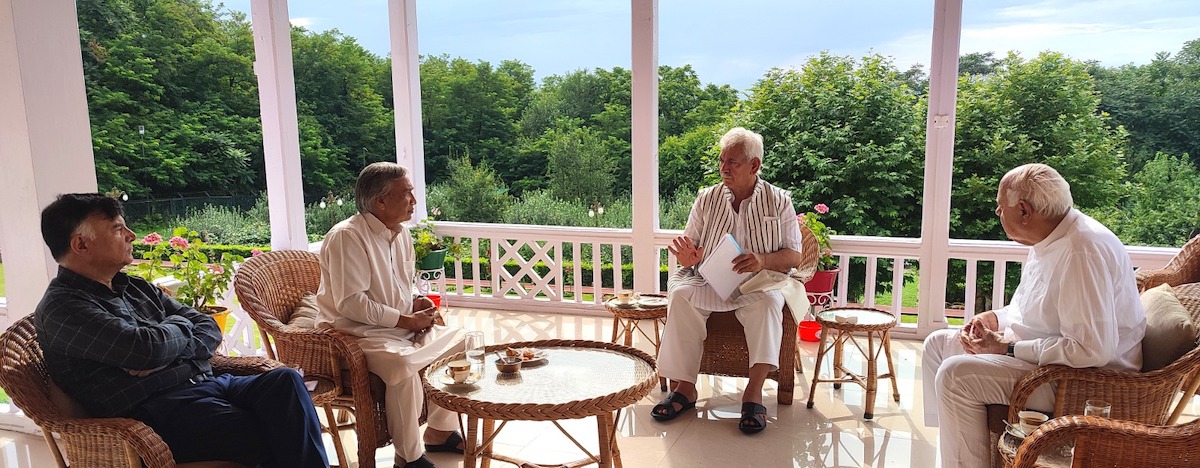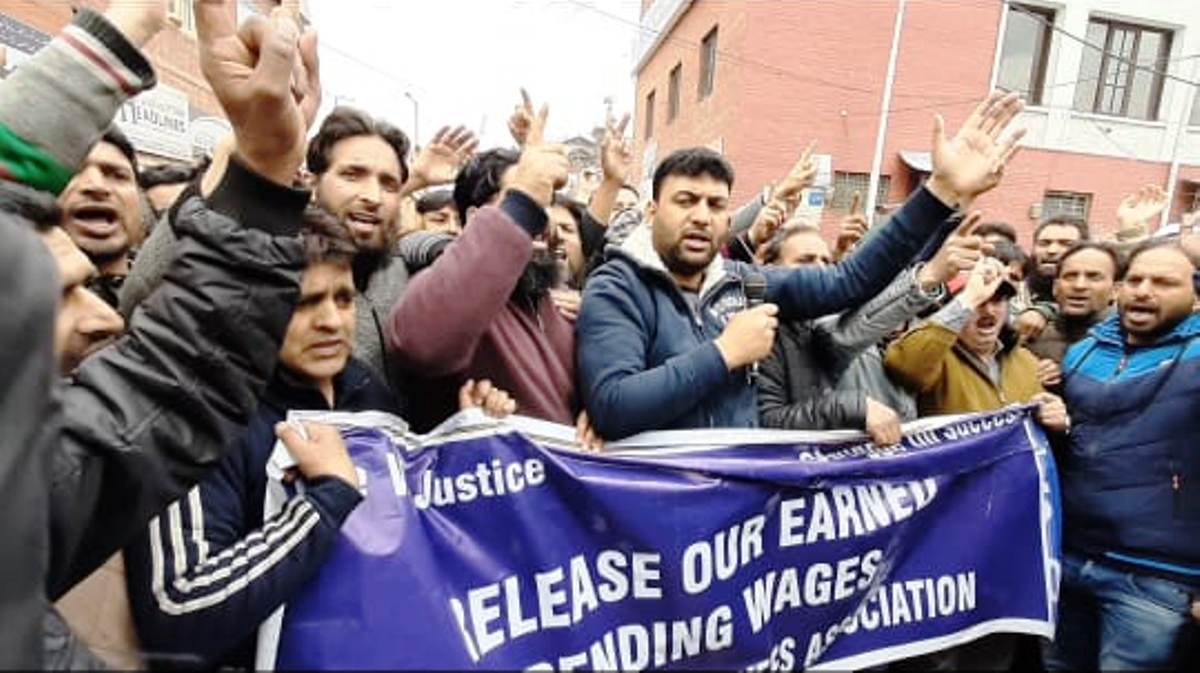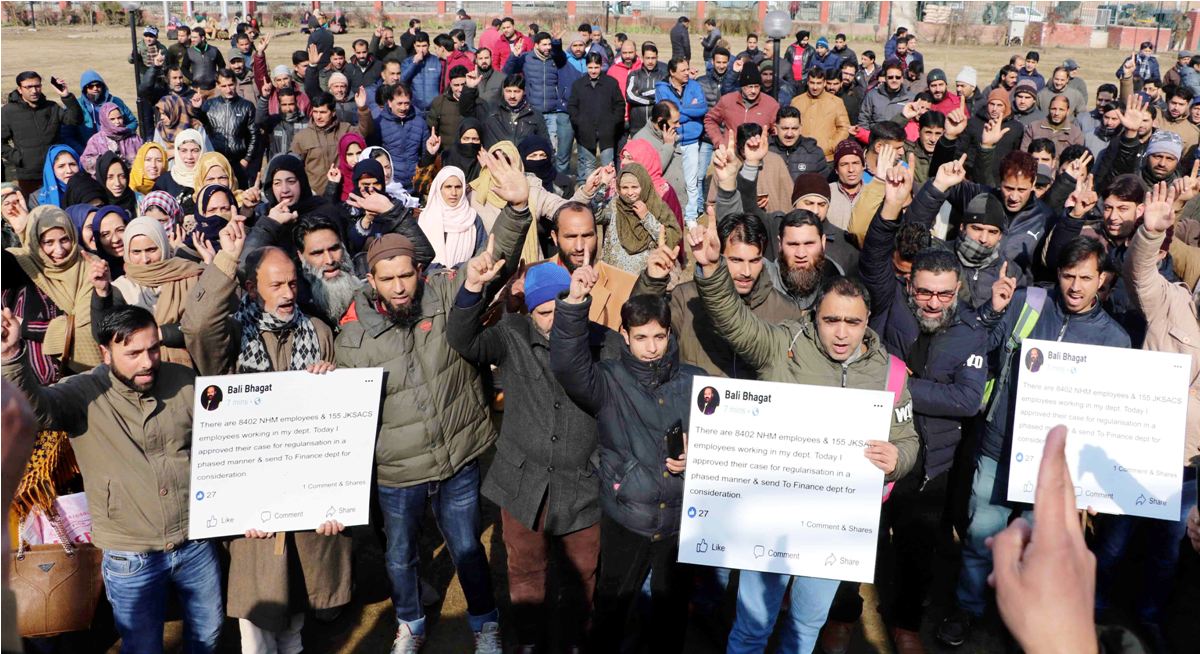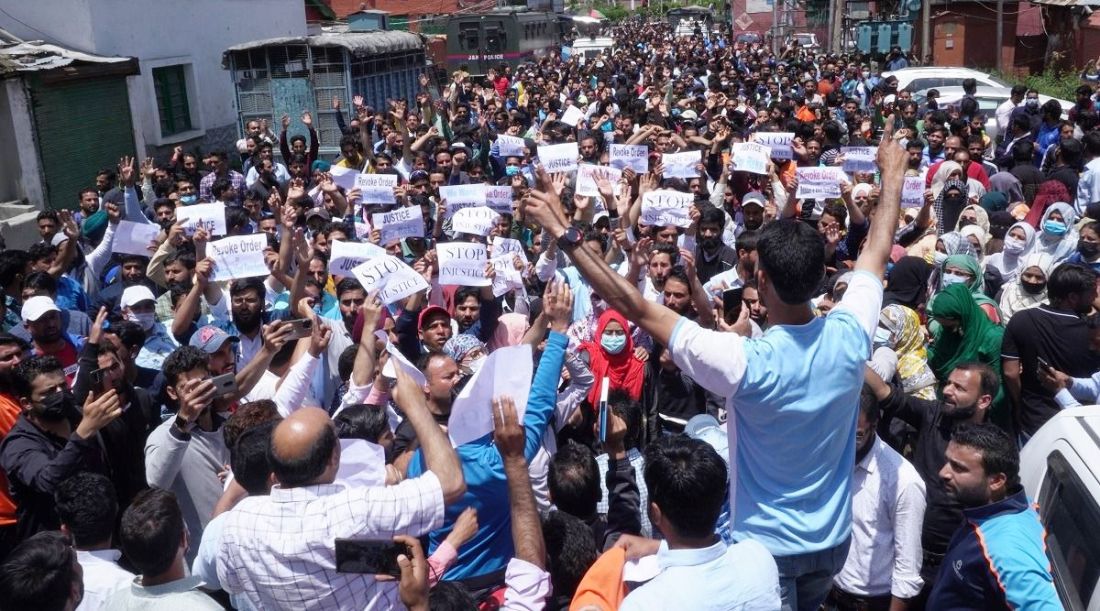With joblessness at its peak and the markets in a slump, frustration is soaring in Jammu and Kashmir’s youth bulge which has nearly eight lakh people seeking livelihoods. The Jammu and Kashmir government, which has traditionally remained the employer of last resorts, is now being run by slightly more than 412 thousand people, the lowest number of people on its rolls in the last decade, reports Masood Hussain

On July 22, Dr Farooq Abdullah, Jammu and Kashmir’s 5-time Chief Minister accompanied Comrade Yousuf Tarigami and his erstwhile colleague, Dr Mehboob Beig, now with PDP, to a meeting with Lt Governor Manoj Sinha. Though it indicated that the PAGD (People’s Alliance on Gupkar Declaration), a loose alliance seeking pre-August 2019 Jammu and Kashmir, the meeting had something more important to discuss.
The trio strongly conveyed that taking away the residual autonomy from the Sher-e-Kashmir Institute of Medical Science (SKIMS) was an unwelcome step. Sipping tea, in the 30-minute long meeting, they suggested the institute must be permitted to fill up its vaccines in the interest of patient care. Authorities had conveyed to the SKIMS management on July 11 that all appointments would now be made by the Jammu and Kashmir Public Service Commission (JKPSC). “If PGI Chandigarh – also operating in a UT, can shine while enjoying absolute autonomy in decision-making, why the SKIMS cannot,” they asked.
The SKIMS, Kashmir leaders told Sinha has 1201 positions – 115 faculty, 149 gazetted, 870 non-gazetted and 67 senior and junior resident berths – were vacant. “There is a 50 per cent of shortage of all technical and nursing staff,” Tarigami later said. “The recruitment has not been conducted for the last seven years.” They said they also highlighted the problems that other healthcare institutions are facing right now.
Sinha, according to Kashmir leaders expressed his concern and ensured that he will examine it as early as possible. “He actually read the entire memorandum in our presence and offered his responses,” one leader, who has been present in all the three meetings they had with Sinha in the last year, said. “He did mention the bungling of the (recruitment) Board also but we insisted that given the public interest, the hospitals should not suffer.”
Not SKIMS Alone
While the Kashmir leaders went to Raj Bhawan with the crippling crisis in the SKIMS, the fact is that almost every other hospital is suffering. The same day, the High Court in Jammu directed the administration to submit details of the steps it is taking to fill up the vacancies in the hospitals. The Medical Education department had earlier informed the court that it has 5876 positions of doctors, paramedics, and Class IV employees vacant across Jammu and Kashmir.

Both regions are suffering. Jammu has 664 doctors and 2489 non-gazetted positions vacant. Kashmir vacancies include 72 doctors and 2651 non-gazetted berths.
A response to an RTI on July 15 revealed that in Shri Maharaja Hari Singh (SMHS) Hospital, one of Srinagar’s key hospitals, 2169 people died in the last nine months. One of the reasons could be the non-availability of the staff. It has 275 positions lying vacant.
The crisis is not in the health sector alone. Almost every department has lot many positions lying unfilled. In the power sector, for instance, JKEEGA last week wrote to LG Sinha offering a break-up of 721 positions – two Managing Directors, four Executive Directors, five Chief Engineers, 14 Superintending Engineers, 62 Executive Engineers, 134 Assistant Executive Engineers, 167 Assistant Engineers and 333 Junior Engineers, which have not been filled.
“Our asset base has increased by 3000 per cent in last 30 years but we are running the four post-unbundling corporations with less than 50 per cent of the human resource,” Perzada Hidayatullah, the JKEEGA, Secretary General said. “The regularisation of the engineers against the positions they are holding has been inordinately delayed even after the State Administrative Council (SAC) approved it as early as October 22, 2019.” As a result of this, the top corporation honchos while holding the positions of Chief Engineers are practically drawing the salaries of junior or middle-level engineers. “The situation at HOD levels is so grave that this might be the only case across the whole country where a Transmission Corporation has been without the Managing Director for the last year.”
In Central University of Jammu, an RTI revealed, only 107 teaching positions are in place against the sanctioned strength of 178. Of the 119 non-teaching staff, 32 are vacant. In IIT Jammu, another RTI revealed there are only 102 teaching staff in place and 28 are vacant. Against 102 non-teaching staffers, 29 are lying vacant.
In Kashmir’s Kupwara district, yet another RTI revealed in 18 higher secondary and 12 high schools, 128 lecturer positions are vacant.
Rampant Vacancies
As concerned sections in Jammu and Kashmir including politicians are talking about vacancies within the government, they seemingly are oblivious to the reality that the government in Jammu and Kashmir is hugely downsized. The government is run by 412277 employees, the lowest in the last 10 years. This is what the government has formally declared under the Fiscal Responsibility and Budget Management (FRBM) Act 2006, which is a mandatory disclosure of all the budgets of Jammu and Kashmir.

In the last ten years, the highest number of employees on the rolls of the Jammu and Kashmir government was 541528 in 2020-21. The disclosures made by the government under FRBM Act in the last budget for 2022-23 suggest the total number of employees was 412277. It means a net fall of 129301 employees in two years.
Interestingly, however, the outgo from the public kitty for salaries, pensions and other benefits has not gone down. The government booked an expenditure of Rs 29511 crore on this head in 2019-20. Three years later, the costs surged to Rs 35026 crore, according to the disclosures made under FRBM Act.
The number of employees has fallen almost in all departments in PSUs as the table shows. In Jammu and Kashmir’s PSUs, some have ceased to exist. The government companies like JKIDCL, JK Cements, and JK Minerals have ceased to exist. Jammu and Kashmir’s government has already decided to sell the JK Cements and most of its 437 employees (2020-21) have either retired or stood deputed to other departments.
Division of Employees
After the reorganisation of Jammu and Kashmir in 2019, various developments took place. Bisecting the erstwhile state into two federally ruled Union Territories was one major development. It eventually led the government to divide the resources, assets and employees.
On November 15, 2021, the Government approved the apportionment of 11189 employees in 33 departments (excluding PSUs) to Ladakh UT. On May 5, 2022, it got another group of 1083 employees. On April 18, 2023, another group of 1221 employees from 24 departments were given to Ladakh UT.
Retirement Age
By an average, the Jammu and Kashmir administration would see off more than 10,000 employees every year as they would reach the age of superannuation at 58. The employee unions had been seeking an extension in this age given the fact that longevity had improved and people would live way past 80. There are countless instances in which the employees who served the government for thirty years have been taking pensions for more than 50 years. As on May 2023, Jammu and Kashmir has 223737 pensioners.
Eventually, the government announced this major shift in 2014 summer. This put an abrupt brake on the generation of new vacancies in the government for at least two years.
Subsequently, the hiring of newer talent was impacted even though the government changed the upper age limit for getting into government jobs. In order to reduce the revenue expenditure, the government promulgated SRO 202 (J&K Special Recruitment Rules 2015) under which all fresh recruits were supposed to get only basic pay for the first five years of their service. (It was binned by LG GC Murmu in June 2020).
The situation changed in 2018 and things went haywire. Now, every month people are retiring in good numbers and leaving behind vacancies unfilled as a result of which their responsibilities move to incumbent officials in adhoc in-charge capacities.

On October 23, 2020, the government amended Article 226 (2) of the Jammu and Kashmir Civil Service Regulations to include a provision that will empower the administration to retire at any time any government servant in the public interest after he has completed 22 years of service or attained 48 years of age. This was said to be a key requirement for identifying the non-performing deadwood. To implement the provision, the administration has already maintained a register of staff that falls in this age bracket. This is in addition to the outright dismissal of employees under Article 311(2)(C) which allows the government to terminate employees without seeking an explanation from them or ordering an inquiry into their conduct. So far 52 employees have been dismissed for being a “threat” to the security of the state.
The employees are retiring in huge numbers. Between March 2017 and March 2021 – five years – 45173 employees have reached the age of superannuation. These include 9514 in 2017-18, 10836 in 2018-19, 11710 in 2019-20 and 13113 in 2020-21.
Daily Wagers
In Jammu and Kashmir context, a huge basket of ad-hoc staffers including daily wagers, need-based workers, permanent daily labourers and others have remained a permanent issue. By and large, hired on personal likes by top officers or politicians, this had emerged a huge army in itself. They were running almost all the major arms of the service delivery including tapped water (Jal Shakti), Public Works Department, Irrigation and Flood Control, Sericulture, Agriculture, UEED and all the corporations that have emerged after the unbundling of the power sector. They all have been working for the government on paltry monthly wages with irregular schedules of payment, no service benefits on one major promise that their services will be regularised after they put in seven years of uninterrupted services.

Given the culture that they would become regular employees after putting in a stipulated time, they would be presumed to be ‘employees-in-making’. On this basis, they would start raising their families. When the regularisations got delayed, they started coming to the streets for their rights. The last BJPDP government finally understood that this is a serious human issue and must be addressed.
In the first instance, somewhere in 2014, the government announced that they will be counted on the basis of the Aadhar cards. Initially, it was said to be a huge number but eventually, insiders said the overall numbers were somewhere between 61000 to 70,000, excluding CPW, NYC, NHM and other workers who had already some career progression and adjustment mechanism in place with respective departments.
On March 17, 2015, the government issued order 43F which imposed a blanket ban on the appointment of any person as a daily wager. In case of serious requirements, the concerned department was supposed to seek formal permission from the offices of the Chief Secretary and the Finance Department and approval from the head of the state.
On December 21, 2017, the government issued SRO 520 which offered a broader framework for listing all kinds of irregular staffers in the government, identified on the basis of biometrics and skill. It also included a large number of people who donated their lands to the government for various developmental projects in lieu of a job. The order envisaged the setting up of an empowered committee that will consider all the cases and recommend to various departments the creation of an adequate number of positions on a somewhat consolidated wage basis with year-on-year change in hikes.
Regardless of the controversy over the minimum wages act, the government did initiate the regularisation of the daily wagers. “In quick follow up to the decision, almost 573 daily wagers were adjusted in various departments,” Sajjad Parray, who heads the daily wagers union in Kashmir, said. “Then there was a thaw and nothing mowed.”
Right now, Parray said Jal Shakti (PHE) has 10500 daily wagers in Kashmir and 22700 in Jammu awaiting regularisation. In the Roads and Buildings department, Jammu has 1000 and Kashmir 900 daily wagers. In Agriculture and Sericulture departments, Kashmir has 4200 and 1100, respectively and Jammu also has a good number.
Parray said that the daily wagers continue operating in challenging situations with the least wages but live with the hope that one day they will get dignified jobs. “In 1994, there were 300 water supply schemes in Kashmir and the daily wagers were the same – around 10, 000,” Parray said. “Now we have 2500 schemes and the same number of daily wagers is managing them.”
After Power Unbundling
All the power corporations are hugely dependent on the daily wages, most of whom are hugely skilled. “Under SO-109 that was issued at the time of unbundling, it has been clearly said that everyone will be regularised against the vacant position,” Peerzada Hidayatullah, the Secretary General of JKEEGA said. “We have more than 3000 positions vacant and these include 933 engineering positions.”
Irfan Kawa, who heads the PDL-TDL Electrical association across Jammu and Kashmir, said they were performing normally for a long time till the reading down of special status coincided with the unbundling of the power sector. “We were around 30,000 individuals across Jammu and Kashmir who were hired by the department as permanent and temporary daily labourers and we were governed by SRO 381 under which we would work as daily wagers and would get routinely adjusted against resultant vacancies and it was uninterrupted till 2018,” Kawa said. “On January 14, 2019, the department did an exercise to fix the seniority of the PDL-TDL and approved the regularisation of 2500 people. As the department sought approval for the regularisation, it was denied by the secretariat citing SRO 404 of 2018 under which all Class-IV regularisations have to go through the SSB.”
It triggered tensions between the government and the main workforce of the four power corporations and eventually led to an agreement in 2019 for which SO 109 was issued. “This order upheld the traditional process and bypassed the SSB, asking the corporations that they cannot hire fresh people unless the PDL are regularized. We were happy,” Kawa said. “Even though the LG tweeted that PDD PDL people have been regularised, it actually did not happen. Not even the 2500 cases earlier recommended by the DPC were approved, so far.”
Kawa said the four corporations have 12000 PDLs awaiting adjustment, of whom 5000 are in Jammu and 7000 in Kashmir. “Apart from this backlog, we have very emotional issue,” Kawa said. “Many PDLs died in accidents during the work. The government would engage next of their kin and we have 70 individuals working whose relatives – mostly fathers – were killed in accidents while working for the department. The government has stopped paying them for all these years but they all are still working for the department.”
New Hiring
Post-2019, the change took its own time to get conveyed amid restrictions, internet shutdowns and arrests. Once the semblance of normality resumed, rules were changed, the mandate restructured and the SSB was asked to make recruitments.

The recruitment process had barely started when a racket surfaced in Jammu. It essentially revolved around the selections that the JKSSB had made in 972 positions of Finance Accounts Assistants (FAA). As the fingers were raised over the unfair process, the government decided to investigate the 1200-odd positions of the Assistant Sub Inspectors (ASI) in the Jammu and Kashmir Police (JKP) as well. It was the first-ever selection by the JKP that had been given to SSB. They also looked into the 163 selections of the Junior Engineers made earlier.
As the preliminary investigations indicated the tip of the mess, the LG administration cancelled the 2335 selections of the three selected lists and handed over the case to the federal investigator, the Central Bureau of Investigations (CBI). A chain of arrests was made and a lot of details somehow moved to the public dominant about the modus operandi of the white collar criminals. The case is in the court of law.
This, however, did not stop the process. By now, the examination for JE and ASI has been held as the SSB is making preparations for holding a new examination for the FAAs.
Overall, not many selections have been made. Informed sources said that since October 2019, the government referred as many as 28000 positions to the JKSSB for selections. Of the estimated 25000 positions advertised by the JKSSB, so far 16500 selections have been made and the rest of the selections are at different stages of the long process.
JKSSB, however, is not the sole recruiter for the government. For all gazetted positions, it is the JK Public Service Commission. Officials are unwilling to talk on the subject. However, data analysis from open-source information suggests the PSC has made around 2600 selections and it is working on another 2300 selections right now.
The government told the Lok Sabha on August 3, 2022, that post-2019, more than 29800 people were recruited in Jammu in Kashmir. On December 8, 2022, the government told Rajya Sabha that 2639 Kashmiri migrants were appointed in the last five years including 841 in 2020-21, 1296 in 2021-22 and 502 in 2022-23. There were some appointments that the army and various paramilitary forces made but the exact data is not available. Jammu and Kashmir Bank, the region’s leading bank also made some recruitments in the last five years. It still is facing staff shortages at the branch level. Apparently, it was on the basis of this information that many politicians suspected the claims made by the government in parliament.

What is interesting, Nityanand Rai, Jr Home Minister told the Rajya Sabha on July 26: “After the abrogation of Article 370, a large-scale recruitment drive was carried out and the government of Jammu and Kashmir filled 29295 vacancies. Recruiting agencies advertised 7,924 vacancies and examinations with respect to 2,504 were conducted.”
Now the question is was the Government of India correct on August 3, 2022, or July 26, 2023? How can the number of post-2019 recruitments be more in 2022 and less in 2023?
The government in Jammu and Kashmir, like other hill states, has remained the employer of last resort. Even in 2023-24, it is expected to book almost 39 per cent of the overall spending in the current fiscal on salaries, pensions and other benefits to its employees. Right now, even after the costs have gone up, the numbers have fallen to an all-time low.
Rampant Joblessness
Jammu and Kashmir is facing a serious lack of job opportunities. The slump in markets is preventing the creation of new opportunities and the government is not in a rush to fill up its vacancies. By the end of March 2023, the data by the think tank Centre for Monitoring Indian Economy (CMIE) put the state of joblessness in Jammu and Kashmir at 23.1 per cent. Nityanand Rai told the Rajya Sabha on July 26 that a survey conducted between July 2020 and June 2021, suggested the unemployment rate among the people of Jammu and Kashmir in the age group of 15-29 years was 18.3 per cent. The national unemployment rate is less than eight per cent.
Jammu and Kashmir has a huge youth bulge. An RTI response recently suggested that by May 2023, Jammu and Kashmir has no jobs for around eight lakh youth. These include 199872 educated individuals listed with the Directorate of Employment.
from Kashmir Life https://ift.tt/Eo87lru
via IFTTThttps://kashmirlife.net
No comments:
Post a Comment